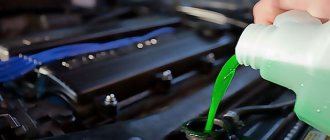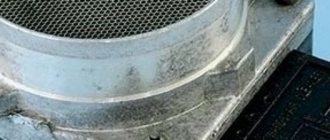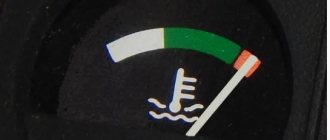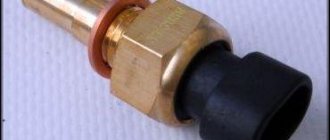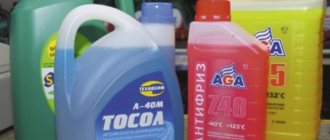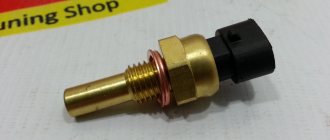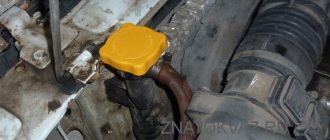According to the recommendation of the AvtoVAZ manufacturer, the coolant in the VAZ 2101-2107 engine must be replaced every 2 years or 45,000 km. Of course, many owners of “classics” do not adhere to this rule, but in vain. Over time, the cooling and anti-corrosion properties deteriorate, which can lead to corrosion in the channels of the block and cylinder head.
In order to drain antifreeze or antifreeze on a VAZ 2107, you will need the following tool:
- Open-end wrench 13 or head
- Sling on 12
- Flathead or Phillips screwdriver
So, before starting this work, it is necessary that the engine temperature is minimal, that is, there is no need to warm it up before this.
First of all, we place the car on a flat, flat surface. The heater control damper must be in the “hot” position. It is at this moment that the heater valve is open and the coolant should completely drain from the heater radiator. Open the hood and unscrew the radiator cap:
We also immediately unscrew the cap from the expansion tank so that the coolant drains from the block and radiator faster. Then we place a container of about 5 liters under the drain hole of the cylinder block and unscrew the bolt, as shown in the photo below:
Since it is quite inconvenient to substitute a large container, I personally took a 1.5 liter plastic bottle and substituted it:
We also unscrew the radiator cap and wait until all the antifreeze or antifreeze drains from the cooling system:
After that, screw back all the plugs except the filler plug and fill the radiator with new antifreeze to the top edge. After this, you need to fill the coolant into the expansion tank. To avoid the formation of an air lock in the cooling system, you need to disconnect the expansion tank hose, as shown in the picture below:
Now we lift the expansion tank up and fill in a little antifreeze so that it flows through the other end of the hose. And at this time, without changing the position of the tank, we put the hose on the radiator. We continue to hold the tank at the top and fill it with antifreeze to the required level.
We start the engine and wait until the radiator fan comes on. Then we turn off the engine when the fan stops working, and after the engine has completely cooled down, we check the antifreeze level in the conservator again. Top up if necessary!
Coolant regulates many important processes in a car. For example, it cools the motor, it affects the temperature sensor and its indicators (during normal operation, the indicator should be at a low level). And in order to maintain all these processes normally, the VAZ 2106 antifreeze must be replaced on time.
Coolant Application
- To maintain normal temperature (sensor) during engine operation.
- To maintain a low temperature (sensor) in the gearbox.
- For lubricating the water pump located in the engine.
- For heating the interior in winter cold.
Replacing antifreeze or antifreeze in a VAZ 2106 car should be done every 45 thousand km or once every two years, depending on the circumstances. Replacement must be made because this substance, like many others, loses its properties over time and succumbs to corrosion. In order to avoid this, you need to change it in time.
About antifreeze and antifreeze
It should be said right away that dividing coolants into antifreeze and antifreeze is accepted only in Russia. To understand why this happened, you need to answer the question: what is coolant anyway?
As a rule, the base for the coolant is ethylene glycol (in rare cases, propylene glycol), to which water and a set of special additives are added to prevent corrosion. Different manufacturers have different sets of additives. And all coolants on the market today are classified according to the technologies for producing these additives. There are three technologies:
- traditional. Additives are made from salts of inorganic acids (silicates, nitrites, amines or phosphates);
- carboxylate. Additives in carboxylate fluids are obtained only from organic carbonates;
- hybrid. In this technology, manufacturers add a small percentage of inorganic salts (most often phosphates or silicates) to organic carbonate additives.
Coolant made using traditional technology is called antifreeze, and liquid made using carboxylate technology is called antifreeze. Let's take a closer look at these liquids.
Antifreeze has several advantages. Let's list them:
- protective film. The inorganic salts contained in antifreeze form a thin chemical film on the surface of the cooled parts, which reliably protects the parts from corrosion. Film thickness can reach 0.5 mm;
Of course, antifreeze also has disadvantages. Here they are:
- small resource. Antifreeze quickly becomes unusable. It needs to be changed every 40–60 thousand kilometers;
- effect on aluminum parts. The additives contained in antifreeze negatively affect the aluminum surfaces in the main radiator. In addition, antifreeze can form condensation. These factors significantly reduce the service life of aluminum radiators;
- influence on the water pump; The tendency to form condensation can also have a detrimental effect on the VAZ 2107 water pump, leading to premature wear of its impeller.
Now let's look at the pros and cons of antifreeze. Let's start with the pros:
- long service life. On average, six liters of antifreeze are enough for 150 thousand kilometers;
- temperature selectivity. Thanks to carbonate additives, antifreeze can more actively protect the engine surface that is hottest than others;
And antifreeze has only one disadvantage: high cost. A canister of high-quality antifreeze can cost two or even three times more than a canister of good antifreeze.
Taking into account all the above advantages, the vast majority of VAZ 2107 owners opt for antifreeze, since saving on coolant has never led to anything good. Almost any antifreeze, both domestic and Western, is suitable for the VAZ 2107. Most often, car owners prefer to use Lukoil G12 RED antifreeze.
Other, less well-known brands of antifreeze are Felix, Aral Extra, Glysantin G48, Zerex G, etc.
How to change coolant
Before replacing the coolant, you need to figure out how to fill it correctly, where, what quantity is needed and what brand. The draining and filling of this substance occurs in the expansion tank, which is located in the engine compartment on the left side of the mudguard on a bracket and secured with clamps.
You will need a volume of 10 liters of antifreeze or antifreeze. Which is better for you? According to reviews, the first one slightly exceeds the indicators; it is also sold in a ready-made form, or it needs to be diluted in a simple proportion (50 to 50). Choose a high-quality and reliable brand.
Before replacing, do not forget to check the temperature indicator (sensor). It is the first criterion that signals immediate replacement. If the temperature is above normal, then start measuring the level. For this:
- Unfasten the rubber strap.
- Unscrew the tank cap and look at the mark (it should be 3-4 mm higher than “min”).
If the level is below normal, then it’s time to start replacing.
Flushing the cooling system
Flushing the cooling system is a very important procedure, since the cooling efficiency of the VAZ 2107 engine depends on it. At the same time, many car enthusiasts prefer not to flush the cooling system, but to fill in new antifreeze immediately after draining the old one. As a result, the remnants of the old antifreeze are mixed with the new coolant, which has an extremely negative effect on its performance. That is why it is strongly recommended to flush the engine cooling system before adding new antifreeze. This can be done either with water or with the help of special compounds.
Flushing the cooling system with water
It should be said right away that it is advisable to use this washing option only when there is no good washing liquid at hand. The fact is that ordinary water contains impurities that form scale. And if the driver still decides to flush the cooling system with water, then the best choice in this situation would be distilled water.
Water rinsing sequence
- Distilled water is poured into the expansion tank of the VAZ 2107.
Distilled water is poured into the expansion tank of the VAZ 2107
- The engine starts and idles for half an hour.
- After this time, the engine is turned off and the water is drained.
The water drained from the VAZ 2107 must be as clean as the water being poured
- After this, a new portion of water is poured into the tank, the engine starts again, runs for half an hour, then the water is drained.
- The procedure is repeated until the water drained from the system becomes as clean as the water being poured. Once clean water appears, washing stops.
Flushing the cooling system with a special compound
Flushing the cooling system with a special composition is the best, but also very expensive option. Because cleaning products effectively remove residual grease, scale and organic compounds from the system. Currently, VAZ 2107 owners use two-component flushing fluids, which contain both acids and alkalis. The most popular liquid is LAVR. Cost - from 700 rubles.
LAVR flushing fluid is the optimal choice for flushing the VAZ 2107 cooling system
Sequence of flushing the system with a special liquid
The sequence of flushing the cooling system with a special composition is practically no different from the sequence of water flushing mentioned above. The only difference is the operating time of the motor. This time must be clarified (it depends on the composition of the selected flushing liquid and must be indicated on the canister with flushing).
Comparison of VAZ 2107 radiator tubes before and after flushing with LAVR
Drain
To get started, make sure you have all the necessary tools:
- key or head;
- screwdriver;
- container for draining;
- stock of new coolant.
Removing the radiator cap
If your engine is cool, you can start working right away.
- Park the car on a level road.
- Open the hood and remove the radiator cap.
- Unscrew the cap from the tank.
- Place a container for draining (one that can hold at least 5 liters).
- Unscrew the bolt and also the radiator cap. Now you can drain everything.
Fill in
If the first part of the procedure was successful, then you can safely proceed to the second.
- Tighten the bolt.
- Fill the radiator with the required amount of antifreeze or antifreeze.
- Remove the hose and let the substance flow into it so that it flows out the other side. Lift the tank, insert the hose and pour in completely.
- Turn on the engine before the fan starts.
- Turn it off and check the sensor and level.
- Now tighten the radiator cap and tank cap. Screw on the cap and close the hood.
Done, the replacement in the VAZ 2106 was completed successfully.
Why does it flow
If the lubricant level in your VAZ 2106 car begins to decrease, then there is a high probability that a leak has occurred and before changing it, you need to “patch” the leak site. Finding it is sometimes not very easy. Try searching in places like:
- clamps (it is possible that they are not clamped well);
- radiator (mechanical damage);
- pump (pump worn out);
- leakage from under the head;
- leak into the cabin.
In some cases, you will have to replace the part, in others you will just have to screw it in, seal it and weld it, but there are also cases when the matter requires serious repairs and you will have to take the car to a service center. Therefore, pay close attention to your car and monitor the level and temperature.
Replacing antifreeze on a VAZ 2107
Before starting work, let's decide on the tools and consumables. Here's what we need:
- canister with new antifreeze (6 liters);
- open-end wrenches included;
- a bucket for draining old antifreeze.
Sequence of work
- The car is installed on an overpass (or, as an option, on an inspection hole). It is better if the front wheels of the car are located slightly higher than the rear ones.
- On the dashboard you need to find a lever that controls the supply of warm air into the cabin. This lever moves to the far right position.
Video “Draining the coolant”
Good afternoon, today we will tell you how to independently replace the coolant in a VAZ-2107 (or any other classic). There is nothing complicated in the procedure for replacing antifreeze in the engine cooling system, the main thing is to adhere to the following recommendations - perform the operation of draining the antifreeze only on a cold engine, you can on a warm one, but in no case on a hot one, this is dangerous, just trying to unscrew the radiator neck cap If it's hot, it can cause burns. So let's get started. We will assume that the engine has already cooled down and we are ready to drain the coolant. We will need a 13 key to unscrew the plug on the block and a 22 key to unscrew the plug or sensor at the bottom of the radiator, depending on the model and configuration of your classic. We also need the antifreeze itself, we used the following coolant:
First of all, unscrew the cap on the radiator neck. Then the antifreeze will drain much faster.
Then unscrew the coolant temperature sensor at the bottom of the radiator:
Or a faucet, depending on the modification of your car (different classic models use different types of radiators)
After the antifreeze has drained from the radiator, or without even waiting for it to finish, unscrew the 13 plug on the block with a wrench:
After all the coolant has drained from both the block and the radiator, we screw back the sensor (plug) and the plug on the block, pull it through carefully, and proceed to filling in new antifreeze. We fill it through the filler neck on the radiator. And here’s another little secret - in order to avoid air locks after filling in new coolant, you need to unscrew and throw off this hose, shown below in the photo:
and pour antifreeze into the system until excess coolant begins to drain from it. That's all, congratulations, you have learned how to change the coolant in your classic , and you have learned how to do this without air locks in the system. If you still have any questions about this procedure, we are waiting for you in our VAZ classic club on the forum .
About antifreeze and antifreeze
It should be said right away that dividing coolants into antifreeze and antifreeze is accepted only in Russia. To understand why this happened, you need to answer the question: what is coolant anyway?
As a rule, the base for the coolant is ethylene glycol (in rare cases, propylene glycol), to which water and a set of special additives are added to prevent corrosion. Different manufacturers have different sets of additives. And all coolants on the market today are classified according to the technologies for producing these additives. There are three technologies:
- traditional. Additives are made from salts of inorganic acids (silicates, nitrites, amines or phosphates);
- carboxylate. Additives in carboxylate fluids are obtained only from organic carbonates;
- hybrid. In this technology, manufacturers add a small percentage of inorganic salts (most often phosphates or silicates) to organic carbonate additives.
Coolant made using traditional technology is called antifreeze, and liquid made using carboxylate technology is called antifreeze. Let's take a closer look at these liquids.
Antifreeze has several advantages. Let's list them:
- protective film. The inorganic salts contained in antifreeze form a thin chemical film on the surface of the cooled parts, which reliably protects the parts from corrosion. Film thickness can reach 0.5 mm;
Of course, antifreeze also has disadvantages. Here they are:
- small resource. Antifreeze quickly becomes unusable. It needs to be changed every 40–60 thousand kilometers;
- effect on aluminum parts. The additives contained in antifreeze negatively affect the aluminum surfaces in the main radiator. In addition, antifreeze can form condensation. These factors significantly reduce the service life of aluminum radiators;
- influence on the water pump; The tendency to form condensation can also have a detrimental effect on the VAZ 2107 water pump, leading to premature wear of its impeller.
Now let's look at the pros and cons of antifreeze. Let's start with the pros:
- long service life. On average, six liters of antifreeze are enough for 150 thousand kilometers;
- temperature selectivity. Thanks to carbonate additives, antifreeze can more actively protect the engine surface that is hottest than others;
And antifreeze has only one disadvantage: high cost. A canister of high-quality antifreeze can cost two or even three times more than a canister of good antifreeze.
Taking into account all the above advantages, the vast majority of VAZ 2107 owners opt for antifreeze, since saving on coolant has never led to anything good. Almost any antifreeze, both domestic and Western, is suitable for the VAZ 2107. Most often, car owners prefer to use Lukoil G12 RED antifreeze.
Other, less well-known brands of antifreeze are Felix, Aral Extra, Glysantin G48, Zerex G, etc.

